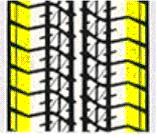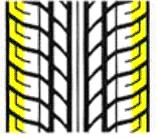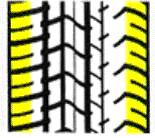Tread Patterns
Below are common tyre patterns and a note of their advantages and disadvantages.
Asymmetric pattern: Tread patterns which differ on each side of the tyre
• Asymmetric tyres have been designed to optimise the opposing requirements of dry grip and water dispersal. They are good for high speed cornering due to the greater contact area which helps reduce tread wear on outside of tyre.
• Asymmetric tyres must be positioned the right way around.
• Best for High performance and motorsport vehicles
Block-shape: Patterns consisting of independent blocks separated by perimeter and lateral grooves
 • Block patterns provide good steering control and stability on wet and snow covered roads. They have good water dispersal qualities.
• Block patterns provide good steering control and stability on wet and snow covered roads. They have good water dispersal qualities.
• However, because the tread blocks are smaller, tyre wear tends to be heavier.
• Application: Suitable for winter or all-season passenger car tyres as well as for the rear wheel use in ordinary applications
Directional pattern: Tread patterns typified by lateral grooves on both sides of the tyre that point in the same direction

• Advantages are good driving force and braking performance. In particular directional patterns provide good water dispersal on wet roads.
• Directional tyres must be mounted in the direction of the tread pattern
• Applications: Passenger car tyres for high speed








